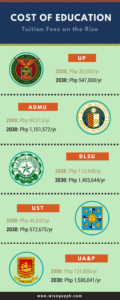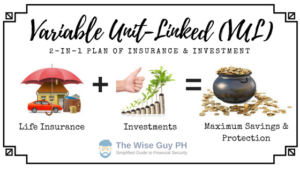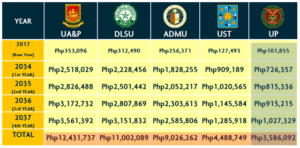
Financial planning is difficult, especially to us Filipinos, because of the rampant bahala-na attitude in our society. Most of us have mastered the art of procrastination. We often say “sa susunood na lang ako mag-iipon” until we forget that time is running out. Hanggang sa nagsilakihan na ang mga bata pero wala parin naiipon. In the end, our kid’s may suffer from our mishaps.
Not unless, of course, our salary is enough to cover the expenses when our kids are about to enter college or we are still alive by that time (no one knows if we are going to die young, leaving our family financially distressed).
People tend to fear the things they do not know, like making an educational fund, to the point that many end up missing the opportunity. This could actually help them lessen the financial burden of sending their kids to college. One of the reasons they might have is that no one in the family has ever tried to make a fund dedicated to their kids’ education. Or they might have heard these pre-need plans (educational plan) not being able to give payouts as promised.

Table of Contents
Educational Fund vs. Educational Plan
An educational plan is a plan bought by parents in contemplation for the college education of their kids. The plan provides a guaranteed amount every year for a 4, 5, 7-year course, depending on the provider. This is the plan most of us know as it is highly publicised of not being able to meet their promises to their clients. A payout is being paid much later than expected or some is unlucky not to be paid even a single cent.
On the other hand, an educational fund is made by yourself together with a financial advisor. This fund doesn’t have a fixed payout as the money is placed in investments (i.e. bonds, stocks, vul, uitf, etc.). The good thing about this is that you have total control over how much you want to have by the time your kids enter college, as the fund is variable. With professional help on the side, a little to no problem might be encountered.

My Father’s Nightmare: Educational Fund is Unavailable
I remember when I was in my senior year in high school, everyone is cramming to secure requirements in order to take entrance exams. Lucky for me, I was able to pass the exams from my chosen schools. Among the schools I passed, I was thinking about going to the University of Sto. Tomas (UST) or Polytechnic University of the Philippines (PUP). From the two, I picked UST because of the honor and prestige attached to its alumni. When I told my father about it, he immediately told me to consider other options as he was not financially prepared to send me in UST. We only have our fish ponds during that time to sustain our living expenses, which is not enough to cover the high cost of tuition in UST.
As a good son, I chose to be practical, thinking I can still study elsewhere to get my masters degree. Anyway, I love my father despite that. I would definitely love him even more if he prepared for our education. Kidding aside, PUP happens to be a good decision, as I was able to finish my degree in electronics engineering on time. Plus, where in the Philippines can you enroll for only Php 12 per unit? What’s more satisfying is the fact that my first paycheck is more than enough to cover the total tuition fees my father paid for my education.
Plan Your Kid’s Future with Educational Fund

But my story might be a little different than yours. What if your child would like to study a specific/unique course that is only offered by a single university. What would you do if you were not prepared to send him to that university? If you prepare as early as today, this could not happen to your kids. Choosing between what they like and what’s practical. I know every parent would like to give the best things to their family. That’s why we have the phrase “hanggat kaya kakayanin”.
Cost of College Education is on the Rise

The schools were chosen for presentation purposes only and has no meaning or bearing in the ranking of universities in the Philippines.
A 12.25% rise in tuition fees is experienced every year, according to the CHED-published 2008 Annual Tuition Fees in the Philippine Daily Inquirer. This is shocking, or more alarming, to know how much is needed to send your kids to the best university after 15 years. Most of us have a preferred school already where we want our kids to study. The table projects the future cost of education at the five most popular choice of school.
The increase in tuition fee is a way for the institutions to cope up with inflation, the salary increase of staffs, improvement of their facilities, etc. Basically, the quality of education they provide is the sole reason why you wanted to send your kids to any of these universities. This corresponds to the high cost of education every parent should prepare as early as your child is born.
VUL Plan: Income Protection with Investment

Life Insurance
To ensure that your kids can still go to college with or without your physical presence. Though you are capable of sending your kids to the best schools today. There is still no certainty that you will still be around by the time they enter college. In other words, insurance prevents our dreams of having our family die together with us. According to Benjamin Franklin, the only certain thing in life are death and taxes. It is morbid to think but death is inevitable and must be considered in planning for the future of your family. You don’t want your kids to stop studying, right?
Investment Component
Your investment/premium will generate income in terms of interest that will be enough to cover or at the very least lessen your worry about your kids’ education. The amount will be dependent on how much you invest; the higher your investment, the higher the return. Time is also a big factor to consider. Don’t expect that you can generate millions just investing few thousand in a short amount of time.
If you don’t have enough money, you should have at least enough time. I heard a lot of parents who are willing to give this a shot, but they only have a few thousand per month (it’s okay to start low), and the worst part is their kids will enter college in 5 years time. There’s no such thing, not unless you have hundreds of thousands to put in high yield but risky investment vehicles like equity/stocks then, 5 years may be enough. Educational planning needs more time than that if budget is limited. It should start as early as your child is born.
 Sample Proposal:
Sample Proposal:
Federico Suan, Jr. who is 25 has a newly born son who will study after 17 years from today (2017).
Annual Premium: Php 200,000 (5 years to pay)
Monthly Premium: Php 16,670
Total Investment: Php 1 Million
Projected Fund Value after 17 years: Php 3,768,544
After 17 years, the projected fund value is enough to send his kid to UP for a 4-year course. Imagine that he invested only Php 1 million, but the fund was able to reach the desired amount that he needed to send his son to a reputable university. The premium might be a little pricey for others, as Php 200,000 per year is already a big amount, but as discussed, the plan is a variable plan. Anyone can start small, then gradually increase the investment when they have more money to invest. We are talking about action here. If you do not start now, most likely you will never start at all because you find it too late. In the first place, you encountered it early but believed that it was too early when, in fact, it was just the perfect time.

OTHER BENEFITS:
Life Coverage: Php 800,000
This is the amount of money my family will get just in case you die due to an accident, illness, or natural cause. This is the amount of money I can leave peacefully to my family without worrying what will happen to them. Because the fund is made for the education of my child, it is recommended that it be reinvested in a financial vehicle similar to a VUL policy. If Php 800,000 was placed in a fund that earns 10% p.a. it will generate Php 4 Million. It is as if I am still alive, financing my kid’s education.
Total Disability Benefit (TDB): Waiver
This is a rider (optional) that can be attached to an insurance policy. If I get disabled and can no longer work, this rider will waive my future payments. It is as if I am still paying the premiums. Though optional (it just cost me less than a thousand pesos for it), I consider this a must-have rider in any life insurance policy.
Accidental Death Benefit (ADB): ₱400,000
If I die due to an accident, my family will get this amount together with the life coverage totaling ₱1.2 Million.
VUL policy can be designed to address different need for retirement, education, health protection, etc. A VUL policy got you covered.
WANT A FREE PROPOSAL?
You too can protect yourself from the lingering uncertainties by getting a VUL policy. Some terms are technical in nature that an ordinary person cannot understand without the help of a Licensed Financial Advisor. A personal meeting is strongly recommended. No pressure or obligation on your part will be imposed upon appointment. You may not like it, but it is perfectly fine with me. You can reach me through 0917-775-8352 or e-mail me at federico.suan@gmail.com.
Ton is an electronics engineer, financial blogger, insurance agent, and a certified investment solicitor. A multi-awarded financial advisor with clients ranging from lawyers, doctors, engineers, accountants, business owners, company directors, and OFWs to minimum wage earners had sought advice from him in achieving lifetime financial freedom.


2 thoughts on “VUL Plan for the Educational Fund of Your Kids”
Life insurance is a risk management tool. It’s purpose is for protection. Though permanent life insurance may provide a savings component through the investment, cash withdrawal will impact the sustainability of your insurance, most especially that VUL insurance with a limited number of payment terms. If you are planning to save up for pension, retirement, education, etc, put in a pure investment and not in your life insurance. It would significantly grow than VULs. It is unfortunate that these VULs are sold as a result of the compensation they offer insurance agents. As an FA myself, I pity this kind of misrepresentation.
I beg to disagree. Well, you are coming from a good place but there are things you might have missed. As an insurance agent myself, I do not sell VUL plans because of your reasoning. We have to assess the client and find the right solution.
Btw, I have a separate blog about what you are talking about. I hope it will shed some light on you and those who hate VULs.
http://www.thewiseguyph.com/most-hated-insurance-vul-scam/
You said that it’s a risk management tool. Isn’t the education of kids at risk if their parents are gone too soon? It’s a very long discussion, even Suze Orman said what you said. While it’s true, that is being too idealistic. In reality, how many of us would really form a habit of investing, as in religiously.
I have met people who started investing enthusiastically but ended up with only a few months’ worths of investment. Of course, there are those who formed the habit. Has the right mindset, I may add. But what I am stressing out is that it is not for everyone because some would like guidance, reminder, or feel that they are committed to doing it.
VUL plan works for some. But it’s not for all.
Bottom line, VUL is a good tool. You shouldn’t treat it as the ultimate solution to every risk but then it should still be part of the client’s options.